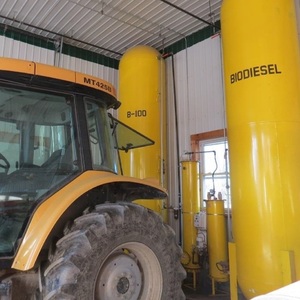New report available for on-farm biodiesel production in Vermont

Photo: Vermont Bioenergy Initiative
February 26, 2016
BY The Vermont Bioenergy Initiative
A new report, On-Farm Biodiesel Production in Vermont: Legal and Regulatory Overview, conducted by the Institute for Energy and the Environment at Vermont Law School reviews all Vermont state and federal regulations related to on-farm biodiesel production. Commissioned by the Vermont Bioenergy Initiative at the Vermont Sustainable Jobs Fund, the report aims to inform farmers about the potential laws and regulations surrounding on-farm biodiesel production.
“As statewide partners begin to find new ways to achieve the goals of Vermont’s Comprehensive Energy Plan, which identified biodiesel as a fuel that will help Vermont meet the 10-percent renewable transportation goal for 2025, the On-Farm Biodiesel Production in Vermont report provides a timely review of the regulations that pertain to home-grown biodiesel production,” stated Ellen Kahler, executive director of the Vermont Sustainable Jobs Fund.
Advertisement
According to the report’s findings, “while several of the federal regulations are only triggered by high levels of production, there are a number of state laws and regulations that may be triggered by small-scale biodiesel production, such as state air emission provisions that establish lower thresholds when compared to the federal Clean Air Act. In addition, it is critical to understand the role biodiesel production plays in the definition of ‘farm’ and ‘farming activities’ for the purpose of states laws, such as Act 250 and the Current Use Program.”
IEE Global Energy Fellow Carla Santos coordinated the legal review with contributions from fellow IEE researchers Diana Chace, Christopher Cavaiola, Jeannie Oliver and Jeremy Walker. The report is broken into five chapters that review tax legislation, site regulations, occupational safety and health, registration and environmental legislation.
“Our institute’s research should help Vermont farmers understand the regulatory hurdles to producing biodiesel on the farm and help them convert a locally grown resource into economic and environmental benefits for Vermont,” said VLS Professor Kevin B. Jones, IEE deputy director.
Advertisement
IEE researchers applied the legal review to three potential scenarios in the report, concluding with a convenient and accessible list of “do’s and don’ts” for farmers to use as a legal checklist as they move forward with producing biofuel in on-farm operations.
The complete report is available on the Vermont Bioenergy Initiative website along with a variety of additional biofuel relevant reports and resources.
Related Stories
A group of 16 senators, led by Sens. Chuck Grassley, R-Iowa, and Amy Klobuchar, D-Minn., on April 8 sent a letter to U.S. EPA Administrator Lee Zeldin urging the agency to increase RVO and account for SREs in the agency’s upcoming RFS rulemaking.
A group of small refineries on April 4 sent a letter to President Donald Trump urging him “to sent the multi-national oil and biofuels companies back to the drawing board to come up with a biofuels policy that does no harm.”
The U.S. Department of Commerce has disbanded an advisory committee that provided the agency with private sector advice aimed at boosting the competitiveness of U.S. renewable energy and energy efficiency exports, including ethanol and wood pellets.
Iowa’s Renewable Fuels Infrastructure Program on March 25 awarded nearly $3 million in grants to support the addition of E15 at 111 retail sites. The program also awarded grants to support two biodiesel infrastructure projects.
Effective April 1, Illinois’ biodiesel blend requirements have increased from B14 to B17. The increase was implemented via a bipartisan bill passed in 2022, according to the Iowa Soybean Association.
Upcoming Events










